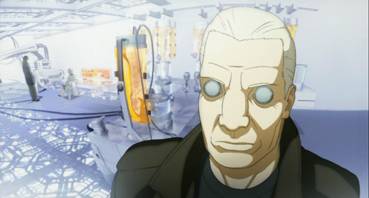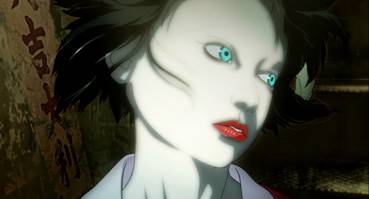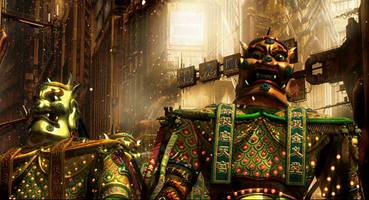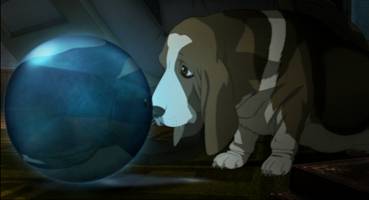|
There
are some novels that you know would make great films but
that you also know will never, paradoxically, be made into great
films. These are stories that would take so much money to
visually realise that they would be impossibly compromised
by the artistically corrupting force of star power
and the Hollywood Machine. Of course, a good part of what makes these
novels such great works is the way they are written, something
that is virtually impossible to translate into cinema. That's not
to say that the right director cannot find a suitably cinematic
equivalent – I can think of plenty of examples of great
films from great books where both works have their unique appeal. But there are plenty of times I'd be
happy for the film-makers to just leave the book alone and
instead take influence from it, admit to the borrowing of
ideas but take them down a their own cinematic path.
One such novel is William Gibson's seminal 1984 science
fiction work Neuromancer. As dense a read as you'll
find in modern sf literature, it's crammed to the gills
with astonishing ideas, visual ideas, the sort of thing that modern,
CG-driven film-making should theoretically thrive on. But despite a string
or abortive attempts, the film version
has never appeared, and despite my initial excitement at seeing
Gibson's words translated into imagery, I couldn't help but breathe a
small sigh of relief. After all, look what happened when
Hollywood took on one of his short stories. Johnny
Mnemonic happened. It had star power (Keannu Reeves),
it had the big Hollywood budget, it even had potential cult
status in the casting of Kitano Takeshi as the bad guy.
And yet it stank. It is now principally remembered as the
film whose completion was marked by the near-fatal
motorcycle accident that almost ended Kitano's career.

And
yet the ideas within Neuromancer, its vision of
a dark, decayed industrial future in which man and machine
are becoming increasingly intertwined. and where the virtual
world is globally connected via 'cyberspace' and 'the matrix'
– terminology coined here for the first time in this context –
have permeated any number of subsequent works of literature and film, and
even society itself ('cyberspace' is now a commonly used
term for the internet and has even entered the Oxford English
Dictionary). The film world actually had the jump on the
cyberpunk movement with Blade Runner,
which pre-dated Gibson's novel by two years, and even Tron's
vision of a physical cyberspace is in the Neuromancer
ball park. Cinematic cyberpunk otherwise remained largely on the fringes,
at least until 1999 when it went global with The
Matrix. But in the end it was not Hollywood that most effectively embraced many of the novel's most
intriguing concepts, but Japanese anime, and specifically
Oshii Mamoru's 1995 Kôkaku kidôtai,
or as it was known in the west, Ghost in the Shell.
Based on the manga by Msamune Shrow, Ghost
in the Shell was, like Ôtomo Katsuhiro's Akira before it, a rare thing in anime, a film that single-handedly expanded the genre's fan base.
Set in 2029 in a world in which networking is far more than
just a business term, the story revolves around Section
9, an elite undercover security force formed to combat the
activities of sophisticated hackers and cyber-criminals.
The Section's most skilled and powerful operative is Major
Motoko Kusanagi, whose cybernetic body carries only the
brain of the original human she once was and what is referred to as her 'ghost',
the essence of her original self or her soul, if you will.
Her long-standing friend and occasional partner is Batou,
a cybernetically enhanced operative of almost equal skill
and commitment, while the mission around which the film revolved saw them trying to track down and
destroy a particularly skilled hacker known as 'The Puppet
Master'.
Almost
as dense in its plotting and texturing as Neuromancer
itself, Ghost in the Shell demonstrated
that the anime feature could be as complex and intelligent
as even the smartest live action film and a good deal of
science fiction literature. As striking for its design and
animation as for its plotting and characters, the film managed
a near-perfect mix of action, narrative, technology and
philosophy that was targeted squarely at adult audiences
– this was NOT one to take your kids to. The film developed
a serious fan base and to this day is rightly regarded as
one of the key works of both anime and science fiction cinema.

News
that a sequel was on the way generated considerable excitement
within the realms of anime fandom, but the frustration factor
of having to wait almost two years after the film's Japanese
release for the film to reach UK screens no doubt prompted
an awful lot of internet downloads. I was fortunate enough
to see it in the first month of its release in Tokyo,
and on my return to the UK the mere mention that I'd done
so prompted the most unexpected people to suddenly turn
their heads, widen their eyes and ask urgently, "You've
seen it?!" Yes, it generated that level of anticipation.
When the fans finally got to see the film they'd been so anxiously waiting
for, reaction was a little mixed, something I also experienced
at that first screening in Japan. But the passing of time seems to have changed
all that, and the film's reputation has been steadily climbing.
Personally, I never had any doubts, as from my first viewing
– without the aid of English subtitles I should add – I
knew I had witnessed something that was every bit as special
and spellbinding as the original.
The
year is now 2032 and Batou is cybernetically enhanced to
such a degree that only his mind remains as it once was,
one haunted by the memory of his vanished ex-partner,
Major Motoko. Now teamed with the younger, largely human
Togusa, he is called in to investigate the case in which
a Gynoid – a realistic female robot created specifically
for sexual companionship – has malfunctioned and slaughtered
its owner. The case turns out to be far more complex than
it first seems, bringing the pair into conflict with everyone
from violent Yakuza gangs to powerful hackers, and Batou
towards a meeting with an old friend and colleague...
Although
Ghost in the Shell 2: Innocence shares
much with its predecessor, it is in as many ways a starkly
different film, something hinted at on the original Japanese release,
where the posters did not include the Ghost in the Shell prefix
and the film played simply as Innocence. That said,
I would still recommend anyone who has not already done
so to see the original before approaching this sequel –
even genre fans have had trouble deciphering some aspects
of its almost dream-like narrative, and you'll need more
than the supplied textual prologue to really understand
what is going on with the characters, especially Bataou,
who has been moved here to centre stage.

There
are inevitable comparisons to be made with Blade
Runner, from which Innocence borrows
plot points and imagery, something that Oshii freely admits
to – he goes as far as suggesting that all films set in the future are now
influenced by it. Oshii even borrows from his own previous
work, recreating a memorable scene from the live action Avalon (widely considered to also be part
of the Ghost in the Shell universe) in
which the lead character simply prepares food for
his dog, a basset hound glimpsed only briefly in the first
film that seems to have become something of an Oshii signature,
and one of the film's key symbols of the innocence of the
title.
But
in all other respects Innocence is as strikingly
original as its predecessor, perhaps even more so. The pace
is slowed, but that in no way dilutes the density of ideas
or the complexity of the narrative. There has been a clear
move away from action towards philosophy, as the two Section
9 operatives move through the investigation and ponder on
both the nature of their prey and of humanity itself, something
that those living in this futuristic society appear to have
completely lost touch with. When the action does come, as
in the battle with the heavily armed Yakuza gang, it is
staged with considerable aplomb, but is always integrated
into the story in ways that sometimes only become clear
after the event. In one of the film's most extraordinary
scenes, Batou walks into a convenience store to buy dog
food, only to hear Motoko's voice tell him "You've
stepped into a killing zone," and a simple shopping
trip turns into a hunt-the-killer game with the store's
occupants, as Batou surveys every corner with Terminator-like
visual enhancement. The scene ends with the suggestion that
it is now Batou who has malfunctioned, but in a time in
which people are able to bio-mechanically connect to the
Network via their e-brains, a skilled hacker is able to
gain control not just of your computer, but your very self.
Elsewhere
the action takes on a more unsettling aspect, exemplified by an opening
sequence in which Batou hunts out the damaged remains of
a Gynoid that has killed two policemen. Dressed and made
up like a Geisha, she is the very picture of delicate womanhood
until she tries unsuccessfully to kill Batou, then tears
open her chest to reveal her biomechanical interior, pleading
for his help as she does so. Is this a malfunction or is
she under some sort of external control? And why would a
robot plead for help? Has it become self-aware? Is it pleading
for its existence or to have hers terminated? Batou obliges
the latter. Later, he does battle with a seemingly
never-ending army of such mechanoids, mechanical representations
of innocence that are slaughtered where they stand. Yes,
there's plenty of metaphorical meat to chew on here.

Clear
explanations are in short supply and even hardened fans
have been left scratching their heads at some aspects.
At one point we appear to be caught in a Run Lola
Run-style replaying of events, each of which differs
slightly from the one before and that only provide an
answer to a problem when the experiences are compared and
combined. If, indeed, they were experiences at all.
Visually
the film is a stunner, the integration of cell-drawn animation
with computer-drawn 3D backgrounds providing a consistently
gorgeous feast for the eyes, with the CGI work never feeling
incongruous or in any way superficial. It has to be said
that the film's considerable visual impact is severely diminished
on the small screen – sequences that made my jaw
drop in the cinema have more of an "Oh that's nice"
quality about them on DVD, lacking the sheer scale and level
of detail that only a cinema-sized screen and a 35mm film
print can deliver, although the inventiveness and poetry
of the design and the sometimes beautiful character animation
still leave you agog. The soundtrack is similarly crucial
to the film's other-worldly atmosphere and qualifies as
a sometimes hypnotic art piece, with Kawai Kenji's mesmerising
score once again providing the film with its musical heart.
There are moments – in particular an extraordinary street
parade involving giant mannequins, festival floats and animals
– that seem to have been staged almost solely for their
audio-visual beauty, but they never feel out of place, adding
to the sense of shifting reality and waking dream that dominates
the second half.
There's
no doubt that Ghost in the Shell 2: Innocence
is not for everyone, and even some anime fans, those who like
their action loud and their plots straightforward, are going to struggle
here. There is a feeling of melancholy that runs throughout,
a sense of sadness for a future in which humanity is increasingly
being surrendered to machinery of our own creation, making the
film feel as much Philip K. Dick as William Gibson. One
thing's for sure, despite its influences, it's still primarily
and uniquely Oshii Mamoru, and if you surrender to his distinctive
style and approach then you're in for a cinematic experience
quite unlike any other. It is a bold and visionary work of remarkable
beauty and fierce intelligence, and though it may play just occasionally
like a drugged out evening with two world-weary philosophy
majors, it's still one hell of a trip.
In
common with other Manga DVDs of late, Innocence
impresses in its picture quality, and in terms of detail
fares better than most, something not obvious in the cell
drawn sequences, which have a slight softness that is deliberate
(especially in the final scene). The CGI material, however,
is close to pristine, with the festival parade and the
opening title sequence in particular looking terrific. Colour
reproduction is strong throughout, and the transfer copes
well with the film's varying use of light levels, from the
saturated whites of the crime lab to the shadowy darkness
of alleyways and night-time streets. The picture is framed
1.85:1 and is anamorphically enhanced.

There
are three soundtrack options (well, that's not strictly true,
as all three are available both in the original Japanese
and with a new English dub, which technically makes it six) –
Dolby 2.0 stereo, Dolby 5.1 surround and DTS surround. Although
the stereo track is fine, the 5.1 and DTS tracks are far
superior, with the DTS just having the edge in breadth and
clarity – both have impressive separation and make subtle
and atmospheric use of the rears and the LFE channel. Kenji
Kawai's score sounds terrific throughout.
The
English dub, or should I say American English dub, is very
much a matter of taste, but once again I found it seriously
inferior to the original Japanese. Technically there is
nothing wrong with it, but performance-wise it leaves quite
a bit to be desired, consistently lacking the low key subtlety
of the Japanese track, the dialogue and delivery sounding
too often like a dodgily acted 40s detective story. This
is hardly surprising when you consider that Oshii was not
involved in this dub in any way, and it can thus be argued,
as with any such track, that if you watch the dubbed version
you are not watching the film that Oshii created, but someone
else's version of it – it's not just about what is said,
but HOW the lines are delivered. But even if you allow for
that, the dub here wanders from the original script. While the
subtitles represent a reasonably accurate translation of
the Japanese dialogue, the dub is a localised interpretation,
Americanising the language and, more problematically, making
subtle and at times significant changes to the wording.
For example, "I have requested a data link" on
the Japanese version becomes "They're asking me for
a data link" on the dub; "It delayed our investigation"
is changed to "That's why you didn't get promoted";
and "The brain must have been taken to sell on the
black market" mutates into "Pro-active firewalls
must have zapped him hacking in somewhere." You pays
your money...
One
thing I should mention is that, like Manga's recent Ghost
in the Shell: Stand Alone Complex DVDs, the 2 disc
set here actually contains two copies of the film in exactly
the same cut, but the version on disc 1 has the stereo and
5.1 tracks, while disc 2 has the DTS. Quite why they have
taken this approach is uncertain – the film's length makes
it unlikely that disc space was at a premium, though the
bitrate is consistently high. Most of all, though, it makes
for slightly deceptive advertising – when you buy a two
disk set you expect the second disc to consist primarily
of extra features, which in this case it clearly does not.
There
are two extras on disc 1.
The
Making of Ghost in the Shell 2: Innocence
(16:00) looks very much like a Japanese EPK for the film
(although one made after its entry in Cannes), but is interesting
nonetheless, not least for providing a look at the faces
behind the character voices. There are interviews with Oshii,
composer Kawai Kenji and several of the animators, plus
footage of them at work and some rough drafts of the animation,
all of which is interesting stuff for anyone interested
in the film or the process of animation in general.
Unusually
for an anime feature, there is a Commentary with director Oshii Mamoru and unit director
Nishikibo Toshihiko, conducted in Japanese with optional English subtitles.
Inevitably, there is quite a bit of discussion of the technical
aspects of the design and animation, but they also talk
about the development of character and story, as well as
the thinking behind key scenes. A consistently jovial and
engaging chat, the two praise crew members for elements
they are happy with, but still criticise things they'd like
to have changed or which were hard work to realise. The
scene with Batou and his basset hound prompts some of the
most entertaining banter. The two have plenty to say – there's
not a single dead patch here.
On
the second disk we have SAC 2nd Gig Sneak Peak
(5:01), which is a pop-video commercial for the second series
of the TV spin-off, Ghost in the Shell: Stand
Alone Complex, plus a scattering of extracts.
Only the English dub is available on this one.
Far more interesting is a Face to Face Interview
(23:44) with director Oshii Mamoru, who kicks of by admitting
that he doesn't mind foreign language dubs of his films,
but that this does result in a different film from the one
he made. I have no doubt that was asked this up front by Manga
in the hope of countering moans about the English dubs.
Sorry, but I'm sticking to my complaints. He also suggests
that no future-set film made nowadays can be free from the
influence of Blade Runner, which
he deeply admires, and talks about the popularity of anime
in the west, the differences between the two Ghost
in the Shell films, the importance of the relationship
between humans and pets (his dog Gabriel was the model for
Batou's own pooch), and whether it really is possible any
more to create a film that can truly be considered original.
The
Full Length Japanese Trailer
(5:31) is exactly that, and without the aid of English subtitles.
Cut to the Kimiko Itou sung Follow Me, heard over
the film's closing credits, it captures the tone and pace
of the film rather well, and is a rather seductive piece.
Also
included are Trailers for five
other Manga releases.
It
may not work for everyone, but for me it just keeps getting
better with every viewing – it's got to the point where I was
watching the Japanese trailer (see above) and going glassy-eyed
every time a favourite scene or shot came on. Although the
narrative clarifies with successive viewings, there is still
plenty that remains deliciously enigmatic and open to personal
interpretation, and as an audio-visual experience it is,
frankly, without peer, but is never emptily so – this is
style with substance, and then some.
Manga's
DVD delivers on sound and picture, and to a degree extra
features, but don't be fooled by the 2-disk status, as the
main special feature is, well, the film itself. Not that
this should put you off – Ghost in the Shell
2: Innocence is anime for adults at its gorgeous
best, and comes enthusiastically recommended.
|